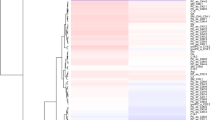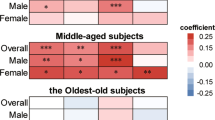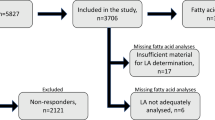Abstract
Background/objectives
To assess the relationship between plasma trans-fatty acids (TFAs) levels and leucocyte telomere length (TL) in a US adult population sample.
Subjects/methods
National Health and Nutrition Examination Survey (NHANES) database was used for this study. Gas chromatography was used to separate derivatised fatty acids (Four major TFAs [palmitelaidic acid (C16:1n–7t), trans vaccenic acid (C18:1n–7t), elaidic acid (C18:1n–9t), and linoelaidic acid (C18:2n–6t,9t)]) which were then quatified using negative chemical ionization mass spectrometry. Data analyses used multivariable linear regressions, while accounting for the survey design.
Results
A total of 5446 eligible participants, with 46.8% (n = 2550) being men, were included. Their average age was 47.1 years for the total sample, and 47.8 and 46.5 years in men and women respectively (p = 0.085 for men vs. women difference). Concentrations of palmitelaidic acid and linolelaidic acid decreased with increasing length of the telomere (p < 0.05). Univariable linear regressions revealed a significant negative association between levels of the palmitelaidic acid, elaidic acid, vaccenic acid, and linolelaidic acid with TL. However when models were adjusted for age, sex, ethnicity, education, marital status, sub-clinical inflammation, body mass index, and smoking, only palmitelaidic acid and linolelaidic acid remained significant (p < 0.05).
Conclusions
TFAs levels and particularly palmitelaidic and linolelaidic acids, are likely negatively associated with telomere lenght. Future studies should explore the potential implications of these associations.
This is a preview of subscription content, access via your institution
Access options
Subscribe to this journal
Receive 12 print issues and online access
$259.00 per year
only $21.58 per issue
Buy this article
- Purchase on Springer Link
- Instant access to full article PDF
Prices may be subject to local taxes which are calculated during checkout
Similar content being viewed by others
References
Mariscalco G, Sarzi Braga S, Banach M, Borsani P, Bruno VD, Napoleone M, et al. Preoperative n-3 polyunsatured fatty acids are associated with a decrease in the incidence of early atrial fibrillation following cardiac surgery. Angiology. 2010;61:643–50.
Stender S, Dyerberg J. Influence of trans fatty acids on health. Ann Nutr Metab. 2004;48:61–6.
Zhao X, Shen C, Zhu H, Wang C, Liu X, Sun X, et al. Trans-fatty acids aggravate obesity, insulin resistance and hepatic steatosis in C57BL/6 mice, possibly by suppressing the IRS1 dependent pathway. Molecules (Basel, Switzerland). 2016;21.
Mozaffarian D, Aro A, Willett WC. Health effects of trans-fatty acids: experimental and observational evidence. Eur J Clin Nutr. 2009;63 Suppl 2:S5–21.
Barnard ND, Bunner AE, Agarwal U. Saturated and trans fats and dementia: a systematic review. Neurobiol Aging. 2014;35 Suppl 2:S65–73.
Smit LA, Katan MB, Wanders AJ, Basu S, Brouwer IA. A high intake of trans fatty acids has little effect on markers of inflammation and oxidative stress in humans. J Nutr. 2011;141:1673–8.
Tomey KM, Sowers MR, Li X, McConnell DS, Crawford S, Gold EB, et al. Dietary fat subgroups, zinc, and vegetable components are related to urine F2a-isoprostane concentration, a measure of oxidative stress, in midlife women. J Nutr. 2007;137:2412–9.
Halliwell B. Reactive species and antioxidants. Redox biology is a fundamental theme of aerobic life. Plant Physiol. 2006;141:312–22.
Sahin E, Colla S, Liesa M, Moslehi J, Muller FL, Guo M, et al. Telomere dysfunction induces metabolic and mitochondrial compromise. Nature. 2011;470:359–65.
Codd V, Nelson CP, Albrecht E, Mangino M, Deelen J, Buxton JL, et al. Identification of seven loci affecting mean telomere length and their association with disease. Nat Genet. 2013;45:422–7.
Cherkas LF, Hunkin JL, Kato BS, Richards JB, Gardner JP, Surdulescu GL, et al. The association between physical activity in leisure time and leukocyte telomere length. Arch Intern Med. 2008;168:154–8.
Valdes AM, Andrew T, Gardner JP, Kimura M, Oelsner E, Cherkas LF, et al. Obesity, cigarette smoking, and telomere length in women. Lancet. 2005;366:662–4.
Kurz DJ, Decary S, Hong Y, Trivier E, Akhmedov A, Erusalimsky JD. Chronic oxidative stress compromises telomere integrity and accelerates the onset of senescence in human endothelial cells. J Cell Sci. 2004;117:2417–26. (Pt 11)
Daniali L, Benetos A, Susser E, Kark JD, Labat C, Kimura M, et al. Telomeres shorten at equivalent rates in somatic tissues of adults. Nat Commun. 2013;4:1597.
Epel ES, Blackburn EH, Lin J, Dhabhar FS, Adler NE, Morrow JD, et al. Accelerated telomere shortening in response to life stress. Proc Natl Acad Sci USA. 2004;101:17312–5.
Ornish D, Lin J, Chan JM, Epel E, Kemp C, Weidner G, et al. Effect of comprehensive lifestyle changes on telomerase activity and telomere length in men with biopsy-proven low-risk prostate cancer: 5-year follow-up of a descriptive pilot study. Lancet Oncol. 14:1112–20.
Shammas MA. Telomeres, lifestyle, cancer, and aging. Curr Opin Clin Nutr Metab Care. 2011;14:28–34.
Serrano AL, Andrés VT. Cardiovasc Dis Does Size Matter? 2004;94:575–84.
Valdes AM, Richards JB, Gardner JP, Swaminathan R, Kimura M, Xiaobin L, et al. Telomere length in leukocytes correlates with bone mineral density and is shorter in women with osteoporosis. Osteoporos Int. 2007;18:1203–10.
Zannolli R, Mohn A, Buoni S, Pietrobelli A, Messina M, Chiarelli F, et al. Telomere length and obesity. Acta Paediatr. 2008;97:952–4.
Willeit P, Raschenberger J, Heydon EE, Tsimikas S, Haun M, Mayr A, et al. Leucocyte telomere length and risk of type 2 diabetes mellitus: new prospective cohort study and literature-based meta-analysis. PLoS ONE. 2014;9:e112483.
Mazidi M, Shivappa N, Wirth MD, Hebert JR, Vatanparast H, Kengne AP. The association between dietary inflammatory properties and bone mineral density and risk of fracture in US adults. Eur J Clin Nutr. 2017;71:1273–77.
Mazidi M, Kengne AP, Mikhailidis DP, Toth PP, Ray KK, Banach M. Dietary food patterns and glucose/insulin homeostasis: a cross-sectional study involving 24,182 adult Americans. Lipids Health Dis. 2017;16:192.
Klein-Platat C, Drai J, Oujaa M, Schlienger JL, Simon C. Plasma fatty acid composition is associated with the metabolic syndrome and low-grade inflammation in overweight adolescents. Am J Clin Nutr. 2005;82:1178–84.
Needham BL, Adler N, Gregorich S, Rehkopf D, Lin J, Blackburn EH, et al. Socioeconomic status, health behavior, and leukocyte telomere length in the National Health and Nutrition Examination Survey, 1999-2002. Soc Sci Med. 2013;85:1–8.
Mazidi M, Rezaie P, Covic A, Malyszko J, Rysz J, Kengne AP, Banach M. Telomere attrition, kidney function, and prevalent chronic kidney disease in the United States. Oncotarget. 2017;8:80175–80181.
Mazidi M, Kengne AP, Vatanparast H. Food Security and Leukocyte Telomere Length in Adult Americans. Oxid Med Cell Longev. 2017;2017:5427657.
Mazidi M, Kengne AP, Sahebkar A, Banach M. Telomere Length Is Associated With Cardiometabolic Factors in US Adults. Angiology. 2018;69:164–169.
Mazidi M, Cicero AF, Kengne AP, Banach M. Association Between Plasma Trans-Fatty Acid Concentrations and Measures of Glucose Homeostasis and Cardiovascular Risk Factors in Adults in NHANES 1999-2000. Angiology. 2017. https://doi.org/10.1177/0003319717745987
Mazidi M, Gao HK, Kengne AP. Inflammatory Markers Are Positively Associated with Serum trans-Fatty Acids in an Adult American Population. J Nutr Metab. 2017. https://doi.org/10.1155/2017/3848201
Mazidi M, Gao HK, Shivappa N, Wirth MD, Hebert JR, Kengne AP. The relationship of plasma Trans fatty acids with dietary inflammatory index among US adults. Lipids Health Dis. 2017;16:147.
Lagerstedt SA, Hinrichs DR, Batt SM, Magera MJ, Rinaldo P, McConnell JP. Quantitative determination of plasma c8-c26 total fatty acids for the biochemical diagnosis of nutritional and metabolic disorders. Mol Genet Metab. 2001;73:38–45.
JK. T. Quality assurance of chemical measurement. Chelsea (MI): Lewis Publishers; 1987.
Teegala SM, Willett WC, Mozaffarian D. Consumption and health effects of trans fatty acids: a review. J AOAC Int. 2009;92:1250–7.
CDC: National Center for Health Statistics. Analytic and reporting guidelines. https://www.cdc.gov/nchs/data/nhanes/nhanes_03_04/nhanes_analytic_guidelines_dec_2005.pdf
Mazidi M, Penson P, Banach M. Association between telomere length and complete blood count in US adults. Arch Med Sci. 2017;13:601–605.
Aviv A. Telomeres and human somatic fitness. J Gerontol A Biol Sci Med Sci. 2006;61:871–3.
Aviv A, Levy D. Telomeres, atherosclerosis, and the hemothelium: the longer view. Annu Rev Med. 2012;63:293–301.
Vallabhaneni H, O’Callaghan N, Sidorova J, Liu Y. Defective repair of oxidative base lesions by the DNA glycosylase Nth1 associates with multiple telomere defects. PLoS Genet. 2013;9:e1003639.
Halliwell B. Antioxidants and human disease: a general introduction. Nutr Rev. 1997;55:S44–9. (discussion S9-52)
Chan R, Woo J, Suen E, Leung J, Tang N. Chinese tea consumption is associated with longer telomere length in elderly Chinese men. Br J Nutr. 2010;103:107–13.
Henle ES, Han Z, Tang N, Rai P, Luo Y, Linn S. Sequence-specific DNA cleavage by Fe2+-mediated fenton reactions has possible biological implications. J Biol Chem. 1999;274:962–71.
Aviv A. Leukocyte telomere length: the telomere tale continues. Am J Clin Nutr. 2009;89:1721–2.
Dhibi M, Brahmi F, Mnari A, Houas Z, Chargui I, Bchir L, et al. The intake of high fat diet with different trans fatty acid levels differentially induces oxidative stress and non alcoholic fatty liver disease (NAFLD) in rats. Nutr Metab. 2011;8:65.
Lee JY, Jun NR, Yoon D, Shin C, Baik I. Association between dietary patterns in the remote past and telomere length. Eur J Clin Nutr. 2015;69:1048–52.
Song Y, You NC, Kang MK, Hou L, Wallace R, Eaton CB, et al. Intake of small-to-medium-chain saturated fatty acids is associated with peripheral leukocyte telomere length in postmenopausal women. J Nutr. 2013;143:907–14.
Aviv A. The epidemiology of human telomeres: faults and promises. J Gerontol A Biol Sci Med Sci. 2008;63:979–83.
Mazidi M, Heidari-Bakavoli A, Khayyatzadeh SS, Azarpazhooh MR, Nematy M, Safarian M, et al. Serum hs-CRP varies with dietary cholesterol, but not dietary fatty acid intake in individuals free of any history of cardiovascular disease. Eur J Clin Nutr. 2016.
Mohsen Mazidi H-KG, Hassan V, Andre Pascal K. Impact of the dietary fatty acid intake on C-reactive protein levels in US adults. Medicine. 2017.
Graakjaer J, Pascoe L, Der-Sarkissian H, Thomas G, Kolvraa S, Christensen K, et al. The relative lengths of individual telomeres are defined in the zygote and strictly maintained during life. Aging Cell. 2004;3:97–102.
Acknowledgements
MM was supported by a TWAS studentship of the Chinese Academy of Sciences.
Author information
Authors and Affiliations
Corresponding author
Ethics declarations
Conflict of interest
The authors declare that they have no conflict of interest.
Electronic supplementary material
Rights and permissions
About this article
Cite this article
Mazidi, M., Banach, M. & Kengne, A.P. Association between plasma trans fatty acids concentrations and leucocyte telomere length in US adults. Eur J Clin Nutr 72, 581–586 (2018). https://doi.org/10.1038/s41430-017-0065-y
Received:
Revised:
Accepted:
Published:
Issue Date:
DOI: https://doi.org/10.1038/s41430-017-0065-y
This article is cited by
-
Functional interaction between plasma phospholipid fatty acids and insulin resistance in leucocyte telomere length maintenance
Lipids in Health and Disease (2020)



